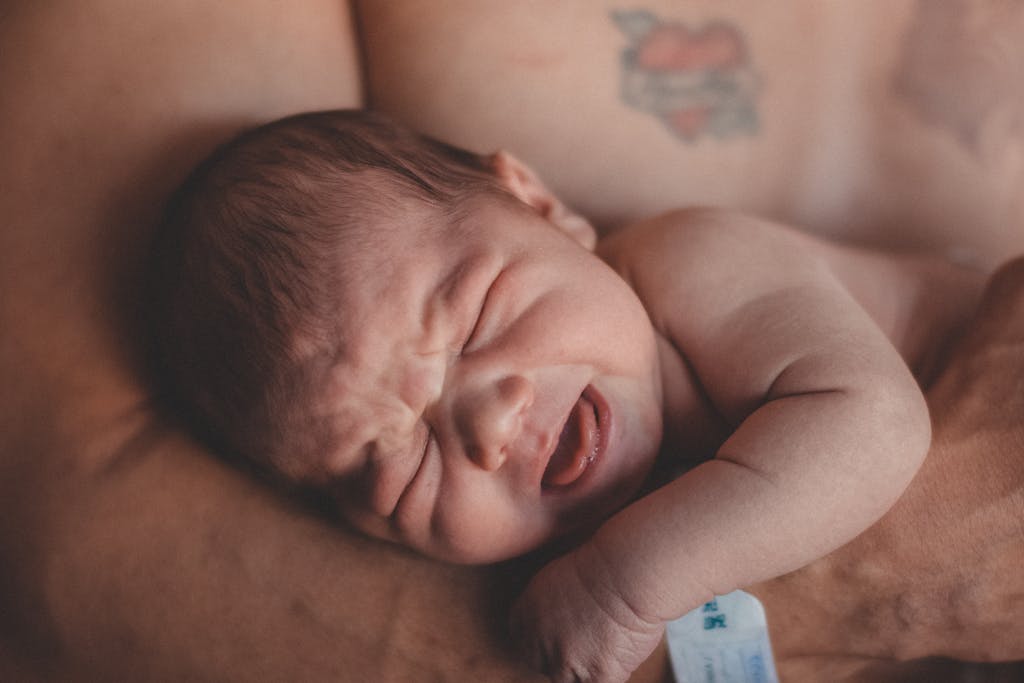There’s that moment—perhaps late afternoon, just as fatigue settles in and the pace of your day has slowed—when your baby becomes unreachably upset. The tears, often copious and seemingly out of nowhere, are paired with a unique kind of distress. Baby discharge crying is an all-too-familiar phenomenon for many parents: the unsettling combination of intense, loud sobs and visible secretions, whether from eyes, nose, or even ears. It’s bewildering, exhausting, sometimes alarming. Questions crowd in. Is this just a phase? Is there pain? Infection? Should a doctor be called, or is this within the bounds of normal newborn experience? The confusion can multiply, especially if simple soothing falls short or the discharge appears strange. Let’s unravel the layers: what sparks baby discharge crying, how to decode accompanying symptoms, which signs warn of possible infection, and when to reach out for medical advice. And yes, practical tips—based on solid medical knowledge and real parental experience—that support not only your infant’s health, but your own well-being as you face these noisy, tearful evenings.
What Is Baby Discharge Crying? Understanding a Baby’s Emotional Storm
Babies, from the very start, have only one real language: crying. But not all crying fits the same template. With baby discharge crying, what you’re witnessing is not a straightforward hunger cue or a damp diaper protest. This is a particularly intense, often inconsolable outburst—most prevalent from two or three weeks of age, sometimes peaking at six weeks, and almost always easing by the fourth month as the nervous system matures. During these spells, babies may produce copious tears or experience noticeable eye discharge, as their tear ducts and emotional centers both awaken.
Think of it as a release valve: infants have limited ways to process the multitude of sensory and emotional stimuli they must confront. So, the tears flow both as an emotional release and as part of developing physiology (the lacrimal glands—the tiny organs that make tears—kick in between one and three months, sometimes creating excess eye discharge). For parents, the sight and sound of this storm can be physically draining and emotionally overwhelming. There is often a gnawing sense of “am I missing something vital?” Yet, this turbulent crying comes with transition and neurological adaptation—it’s temporary, and, provided no red flags are present, can be viewed as a normal developmental passage.
Distinguishing Baby Discharge Crying from Basic Needs Crying
Here’s the tricky part: How do you tell the difference between baby discharge crying and cries for food, warmth, or a diaper change? While all infant cries can start to blur together in the sleep-deprived mind, certain clues stand out. A baby with hunger typically cycles through signs—rooting, fussing—before the crescendo. Discomfort from gas or a wet diaper often leads to grumbling that settles quickly after needs are met.
Contrast that with baby discharge crying: these episodes often seem to appear from nowhere, are sharper and more prolonged, and lack an immediate solution. The baby may arch its back, clench fists, flutter hands chaotically. You scoop, cuddle, rock, but the crying persists. Yes, sometimes a gentle lull or white noise soothes—but at other times, nothing works. This, too, is within the spectrum of normal adaptation to a loud, bright, overwhelming world.
Creating a Calming Environment: Practical Measures That Soothe
Is there a way to soften these emotional waves? Absolutely. The right environment can do wonders—think soft lighting, minimal noise, and a gentle, steady presence. Many experts recommend the use of white noise, soft lullabies, or a rhythmic heartbeat recording. Skin-to-skin time (where baby rests on your bare chest) can lower stress hormones and steady your little one’s heart rate. A warm bath sometimes helps, though during heavy crying, many infants prefer to stay cuddled in trusted arms.
And, when it comes to eye discharge or nasal secretions during these episodes, always reach for a soft, damp cloth. Wipe gently from the inside corner outwards, using a separate cloth for each eye to avoid spreading infection—these tasks, while seemingly small, contribute to both hygiene and comfort.
Diving Deeper: Why Do Babies Cry So Much?
Pausing to unravel the “why” behind infant crying illuminates how baby discharge crying sits within the broader landscape. Hunger, overtiredness, abdominal discomfort (like trapped wind), temperature sensitivity, and overstimulation are classic triggers. Often, these causes are easily solved—the crying abates within minutes.
But between two weeks and four months, another phenomenon arises: the period of PURPLE crying. Here, infants cry for long stretches, typically late in the day, regardless of how proactive you are. This is a distinct developmental phase—persisting even when every “need” is met. Signs? Clenched fists, a red face, arching of the back, a look of near panic. It’s not a sign of poor care. It’s part of the slow maturation of the brain and body, and eventually, it will subside.
Decoding Discharge: What’s Normal and What’s Not?
When crying is paired with eye discharge, nasal mucus, or even ear secretions, unease quickly takes hold. But not all discharge spells infection.
Eye discharge: In the first weeks, clear or slightly yellow tears are common—especially after sleep—often due to a blocked tear duct (meaning tears accumulate before finally being released, sometimes with a little crusting). As tear production establishes, the flow normalizes. Persistent, thick, green or pus-like, or foul-smelling discharge, especially if the eye is red or swollen, signals potential conjunctivitis (eye infection). Medical review is mandatory here.
Nasal discharge: Clear or white mucus is typical, the body’s way of clearing airways. Mild colds (which are common, given immature immune systems) may bring milky discharge. Yellow or green mucus, especially if accompanied by fever, poor feeding, or labored breathing, can suggest a viral or bacterial infection—worthy of prompt medical advice.
Ear discharge: Rare in babies. Pus (yellow or green), blood, fluid—especially if your baby is irritable, febrile, or pulling at the ear—hints at otitis media (middle ear infection) or even a ruptured eardrum. Time to call the doctor.
Genital discharge: Sometimes, newborn girls have a thin, white or slightly bloody vaginal discharge—driven by maternal hormones. This typically resolves in a few days. Yellow, green, foul, or persistent discharge, or any that’s associated with swelling, could indicate infection and should be checked.
Normal discharge is generally clear, mild, and short-lived. Anything persistent, colored, foul-smelling, or linked to swelling, fever, or feeding refusal marks a deviation—medical evaluation is necessary.
The Medical Connection: Causes of Baby Discharge Crying
The physiology is fascinating. Vigorous crying can open up the tiny tear ducts, leading to overflow and eye discharge mingling with powerful sobs. Nasal passages, irritated from the force of crying or environmental factors (dust, pet dander, smoke), may drip more than usual. Babies with blocked or still-maturing tear ducts are especially prone.
Yet, infection always looms as a possibility. Conjunctivitis (eye infection), common colds, bronchiolitis, or otitis media can all ramp up both discharge and distress. In these cases, the discharge is often thick, colored (yellow or green), and paired with other symptoms—fever, irritability, difficulty feeding, and sometimes lethargy.
Hormonal effects? Rare, but not impossible for genital discharge. And colic—a persistent, unexplained crying pattern—may amplify parents’ concern as discharge becomes more noticeable.
Is This Normal? Recognizing Red Flags
How do you tell if baby discharge crying is entirely benign or veering toward danger? Here’s a chart to help:
| Symptom | Normal | Red Flag |
|—————————-|————————————————|————————————————-|
| Crying | Consolable, settles with comfort | Persistent, inconsolable, high-pitched |
| Eye Discharge | Mild, clear/yellow after sleep | Thick yellow/green, lasts >3 days, pain |
| Eye/Eyelid Appearance | No swelling, normal | Red, swollen, hard to open |
| Feeding | Feeds well, normal appetite | Refusal to feed, lethargy |
| Fever | None | Over 100.4°F (38°C) |
| Tears After 2-3 Months | Present during cries | Absent, or suddenly stops |
| Response to Soothing | Settles with comfort | No relief with comforting |
Absence of tears during intense crying after two to three months often means either a blocked tear duct—or, more concern, dehydration. If combined with dry mouth or sunken fontanelle (the soft spot at the top of the head), urgent medical input is needed.
When to Seek Medical Help: Knowing When Attention Is Needed
These are the moments that call for swift action:
- Infection signs: Red, swollen eyes, or eyelids; thick, colored, smelly eye, nose, or ear discharge; persistent secretions.
- Discharge that’s thick, green/yellow, bloody, or odorous.
- Inconsolable or suddenly altered crying, especially if different from usual.
- Lack of tears in older infants, or a rapid change in tear production.
- Suspected injury or visible trauma to the eyes or ears.
- Fever over 100.4°F (38°C), refusal to feed, or lethargy.
Trust instinct. It’s valid and, in many situations, protective.
At-home Care and Comfort: Strategies Backed by Science
- Soothing the storm: Aim for a dim, quiet space. Swaddle, rock, carry, or use a baby carrier to provide safe closeness. Some infants respond best to motion, others to a gentle hum or familiar scent (your skin, clothing).
- Managing discharge: Use clean hands and a soft cloth to wipe away eye discharge or nasal mucus. A fresh cloth for each wipe reduces the spread of bacteria or viruses.
- Blocked tear ducts: A gentle, downward massage from the inner eye corner towards the nose can help. Limit this to a few times daily unless otherwise guided.
- Rest for parents: When exhaustion takes over, place your baby safely on their back in the crib and step away for a moment. Most parents will, at some point, need support—seeking it is not a sign of weakness.
- Never shake a baby. Frustration is understandable in the face of non-stop crying, but shaking poses a grave risk to brain health.
Looking After Yourself: Parental Mental Well-being Matters
Tending to a baby during baby discharge crying is demanding—psychologically, emotionally, physically. It’s not just a question of technique; it’s about endurance. Share responsibilities if possible, express your feelings, and consider parent support groups or forums. Deep breathing, short walks, even a few minutes in a separate room can restore composure. Overwhelm is common and temporary.
If the intensity of crying or troubling symptoms persist and you feel desperate or unable to cope, talk with your healthcare provider. Maintaining your well-being is essential to care for your child effectively.
Key Takeaways
- Baby discharge crying is a frequent and usually self-limiting event in early infancy, often resolving with growth and gentle comfort.
- Look for normal-versus-warning signs—especially thick, colored, or foul discharge, swelling, inconsolable crying, fever, or poor feeding.
- Hygiene basics—soft cloths, handwashing, separate wipes for each eye—minimize infection risks during these episodes.
- Blocked tear ducts are common in newborns and generally resolve, but ongoing symptoms beyond a year may require specialist input.
- Emotional and physical support for yourself is essential—take regular breaks, enlist help, and remember, every challenging phase eventually passes.
- For ongoing advice and free health questionnaires tailored to your child, download the Heloa app—support and reassurance are always at hand.
Questions Parents Ask
Can crying cause a baby to develop eye or nose discharge?
Yes, intense crying can sometimes lead to increased eye or nose discharge in babies. This response is usually linked to the stimulation of tear and mucus glands during prolonged tears. Most of the time, this discharge is clear or slightly yellow and disappears once your little one has calmed down. Rassurez-vous, if the discharge is mild, clear, and not accompanied by swelling, redness, or fever, this is generally considered normal and not a sign of illness.
What should I do if my baby is crying with discharge from the eyes, nose, or ears?
If your baby is experiencing crying and you notice discharge from the eyes, nose, or ears, begin by gently cleaning the area with a soft, clean cloth. Observe the color and consistency of the discharge. When it is clear and your baby has no other concerning symptoms (such as fever, swelling, or refusal to feed), a simple gentle cleaning is often sufficient. However, if the discharge becomes thick, green or yellow, or is paired with symptoms like redness, swelling, fussiness, or poor feeding, il convient de consulter un professionnel de santé pour un avis adapté. Keep in mind that parents know their babies best—the slightest doubt or observation that something seems off is always worthy of attention.
When should I worry about my baby’s crying and discharge?
Il importe d’être attentif à certains signaux : if your baby’s discharge is thick, colored, foul-smelling or persists beyond a couple of days, or if it’s accompanied by signs such as high fever, lethargy, refusal to feed, or significant irritability, do not hesitate to seek medical advice promptly. These changes can sometimes signal an infection or other medical concern that needs prompt evaluation. No question or worry is ever too small when it comes to your baby’s health—trust your instincts and seek reassurance whenever you feel the need.










